Two years ago, Stage, a department store chain serving small town America, found itself in an all-too-familiar situation. Its conventional piece picking and packing operations were being overwhelmed by the growth of e-commerce, especially the growth of multi-line orders. The solution: pouch sortation technology, as the technology is referred to by the system integrator (SDI Systems) that designed and implemented the project.
“As our e-commerce business increased, we added more SKUs to our site which led to more multi-line orders,” explains Steven Hunter, executive vice president and chief operating officer. “We needed to replace our manual picking process with a solution that would automatically bring together all the items in a multi-line order at the packing station.”
The pouch sorter, he adds, not only made an efficient use of space in the warehouse since it was installed overhead in an area that was otherwise inaccessible to automation, it has “given us a material decrease in the time it takes to get merchandise picked and packed inside the four walls of the DC.” Conversely, it also allows Stage to increase the number of units picked and packed in the same amount of time.
What’s more, he adds, the system requires little maintenance and was designed with room to add more buffer space as e-commerce continues to grow.
Big stores, small towns
Stage began operations in the 1920s with the founding of the family-owned Palais Royal and Bealls department stores in Texas. Fast forward more than 60 years, and in 1988 the two chains merged to form Specialty Retailers Inc. (SRI), a privately held company based in Houston.
The merger also set in motion nearly 30 years of acquisitions and expansion, as SRI acquired other retail chains outside its home turf. In 1996, it went public under the name Stage, and by 2004 had exceeded $1 billion in sales, reaching $1.4 billion in sales in 2016.
Today, the company operates six brands in 42 states with approximately 800 specialty Bealls, Goody’s, Palais Royal, Peebles and Stage specialty department stores and 58 Gordmans off-price stores. The company brings to market department stores that average 18,200 square feet and off-price stores of 55,000 square feet.
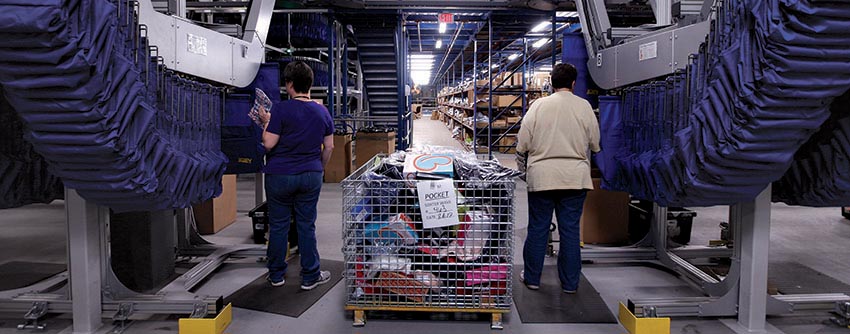
Take a in depth look at the equipment and processes inside the Stage fulfillment center.
That, of course, is a brick-and-mortar distribution strategy. To that end, the Jacksonville, Texas, distribution center, which services most of the stores, was originally designed as a crossdock and flow-through facility, according to James Grundy, vice president of distribution, and James Deal, the director of e-commerce fulfillment.
Up until about 2010, when the company launched its e-commerce site, most of the activity in the 437,000-square-foot facility involved either crossdocking upon receipt or sending items ordered and received in bulk to a value-added processing center, where items were ticketed, put on hangers and prepared for the store, and then built into mixed carton shipments that flowed through the facility. Warehousing was an afterthought.
“We had a small replenishment storage area where we held basic stock items that turned over quickly,” says Deal. “Beyond that, there was very little warehousing inside the building and no outside storage.”
To make that happen, the facility used a combination of automated equipment, including tilt tray sorters, bomb bay sorters, a hang sorter and a conventional conveyor and shipping sorter system.
That all began to change in 2010, when Stage stuck its toes into the e-fulfillment space during the holiday season. Orders from its new Website were filled manually from stock in the replenishment area. Associates wheeled carts through the area to pick to totes. “After the first year, it became evident that if we were going to compete, we had to have a lot more stock on hand and more storage space,” says Deal.
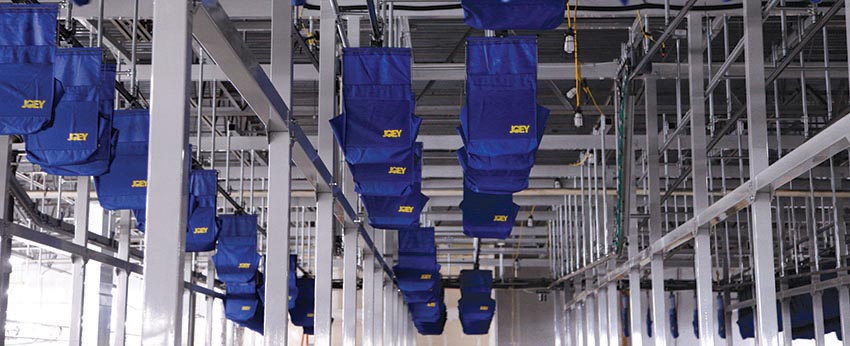
The strategy, according to Hunter, was to add more SKUs online so that e-commerce was essentially Stage’s largest store, with the kind of selection and variety that a shopper would find in a big, urban department store. After all, if a customer couldn’t find what they wanted on a Stage site, they would just go to another site. That led to the addition of what are now three annex facilities located about half a mile from the DC totaling 170,000 square feet and the addition of a 48,000-square-foot, e-commerce mezzanine inside the four walls. All told, the facility was now offering as many as 133,000 SKUs.
The result was a complex DC environment. “We handle brick-and-mortar stores; e-commerce fulfillment; and we’re storing our fastest movers in the main facility while using a system with trucks to bring slower movers from the auxiliary buildings,” Hunter explains.
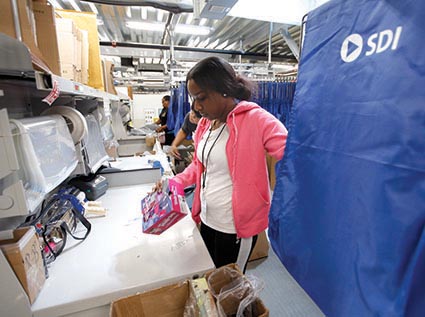 When it came to e-commerce fulfillment, order selectors picked in batches to pallet baskets that were brought on rolling carts to a putwall for packing. “If you had a five-item order, the items might get picked by five different people, some of whom were operating in an annex building, before we brought them together at the putwall,” says Grundy. All of that took time.
When it came to e-commerce fulfillment, order selectors picked in batches to pallet baskets that were brought on rolling carts to a putwall for packing. “If you had a five-item order, the items might get picked by five different people, some of whom were operating in an annex building, before we brought them together at the putwall,” says Grundy. All of that took time.
By Christmas 2015, the manual process had reached its limit. “You get more multi-line orders during the holiday season than at other times of the year,” says Hunter. “No matter how many people we hired for the season, we still couldn’t fill all of the orders efficiently.”
Something had to change by the 2016 holiday season. “Our goal was to increase our fulfillment capacity without expanding our physical footprint and to do so in a cost-effective manner that also allowed us to add capacity for future growth,” says Deal.
It was a big order, and the question was: What technology can make that happen?
In the pouch
By all accounts, pouch sortation, which is more common in Europe, was not the first choice, and probably wasn’t on the initial list of potential technologies to solve the problem.
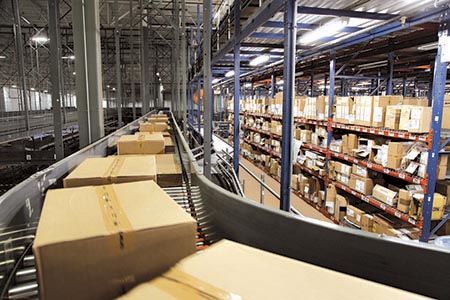 Instead, the team looked at more conventional automation used to aggregate multi-line orders, like tilt tray sortation and goods-to-person solutions. The problem, according to Grundy, is that all of those technologies required floor space and that just wasn’t an option in a facility that was already maxed out. What the facility did have was air. They wondered: Maybe there’s a solution that could take advantage of overhead space?
Instead, the team looked at more conventional automation used to aggregate multi-line orders, like tilt tray sortation and goods-to-person solutions. The problem, according to Grundy, is that all of those technologies required floor space and that just wasn’t an option in a facility that was already maxed out. What the facility did have was air. They wondered: Maybe there’s a solution that could take advantage of overhead space?
“We have a 38-foot clear height in the facility, and there is an area above the cafeteria and control room with nothing there at all,” says Grundy. “It was the only clear air space left in the facility. When we walked through the facility, our system integrator told us about the pouch sortation technology he had seen in Europe.”
Expandability was engineered into the design. “He thought we could hang the pouch sorter from the ceiling up there, and wind it in a way that was expandable if we needed more capacity and space in the future,” Grundy adds.
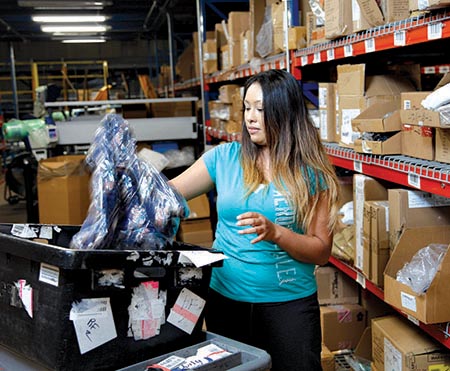 As they familiarized themselves with how the technology worked, the pouch sorter also was more flexible than some of the competing technologies under consideration. “We carry a broad selection of merchandise, everything from towels and sheets to fine jewelry,” says Hunter. “The pouch sorter is so flexible that it allows us to handle merchandise of all different sizes. Competing technologies were more costly and took up too much space that we just didn’t have.”
As they familiarized themselves with how the technology worked, the pouch sorter also was more flexible than some of the competing technologies under consideration. “We carry a broad selection of merchandise, everything from towels and sheets to fine jewelry,” says Hunter. “The pouch sorter is so flexible that it allows us to handle merchandise of all different sizes. Competing technologies were more costly and took up too much space that we just didn’t have.”
The final criteria: They wanted it up and running in time for the 2016 holiday season, which called for a rapid implementation time.
If there was a concern beyond implementation time, it was that Stage would be an early adopter of the technology in the United States. “Our system integrator has been a good partner for us for a long time, so there was already a trust factor,” says Hunter. “We went to see the technology in operation at a DC in Canada and left there cautiously optimistic. We decided to go ahead.”
Going live
Operation of the basic pouch sortation system is straightforward. It consists of 10 induction stations and 25 packing stations, and is capable of handling 1,000 order sorts per hour.
When items are delivered to one of the induction stations, an associate scans an item with a camera-based imaging system, places it in a pouch and scans the license plate bar code on the pouch, marrying the item to the pouch just like marrying an item to a storage location during a putaway process. The pouch is then taken overhead on a powered track to the sortation area.
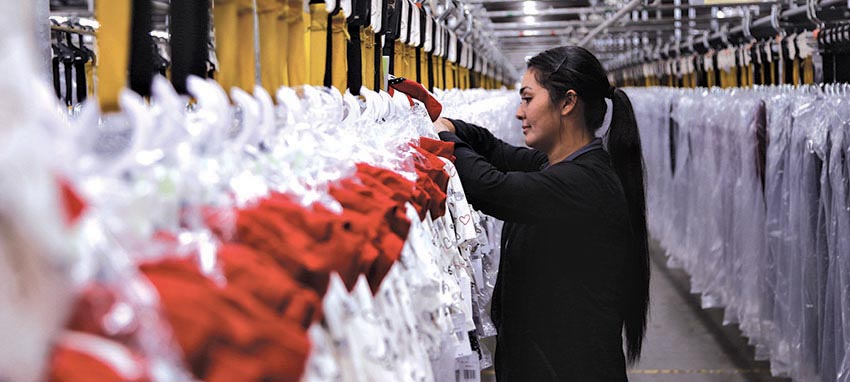
That consists of two sortation buffers: a primary and secondary buffer. Pouches wait in the primary buffer area until the system has determined that all of the items required for a multi-line order are present and available for packing, from wherever they were picked—including slow-movers from one of the annex buildings. At that point, the warehouse execution system (WES) releases complete orders to the secondary buffer area. Once those pouches are in the secondary area, the WES looks for pack stations that are ready for work and releases up to 25 pouches in a single line to a packer. The packer is then directed by the system on how to pack the orders for delivery.
One of the ways the system integrator adapted a new technology to a facility that was already up and running was to mimic the existing processes where it made sense. “In the old process, we batch picked to pallet baskets that we brought to a putwall,” says Grundy. “We integrated that into the pouch sortation system. We still pick to the baskets and roll them over to the induction area.”
If the overall project faced any hurdles it was time. Implementation and go live was scheduled to take nine months and to have gone through all of the dry runs prior to November 2016 so it was ready for the holiday season. As is often the case for early adopters of new technology, implementation took longer than anticipated.
“Our intent was to have completely phased out manual fulfillment before the start of the holiday season,” says Deal. “Because we didn’t finish implementation until November, we took a phased approach to training and going live.” The system didn’t reach full capacity until after last year’s holiday season.
That said, nine months later, Deal, Grundy and Hunter agree that pouch sortation has been an effective solution to Stage’s e-commerce fulfillment challenges. The system is easy to operate and easy to maintain and has delivered a significant improvement in efficiency.
“We’re meeting the needs of our e-commerce business, and we have the capability to expand as our business grows,” adds Deal.
Hunter takes a higher level view. “Customer expectation today is low-cost or free shipping, and they want all of the items for an order shipped together. That has forced retailers to do things quicker, faster and cheaper,” he says. “The pouch sorter solution enables us to fill multi-line orders quickly and get them shipped in most cases all in one package to minimize our shipping costs. It’s been a huge win.”
Take a in depth look at the equipment and processes inside the Stage fulfillment center.
About the Author
Follow Robotics 24/7 on Linkedin
Article topics
Email Sign Up















